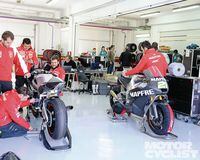The scene: a MotoGP garage during the 2011 season. The rider sits in the rear discussing setup with his technical team. Two bikes rest on their stands, one ready for the next practice session while the other is being prepped with a different setup. One is an experimental “control,” the other is the actual experiment.
It’s the ultimate form of motorcycling: two of the highest performing, highest priced motorcycles on the planet awaiting the decisions of the team members. In another part of the garage, spare parts abound to replace almost any sort of mechanical malfunction or crash damage. Racks of forged-magnesium wheels are fitted with tires for different track conditions: hot or cold, wet or dry. There are steel brake discs for the wet and carbon discs for the dry in two types.
We will see MotoGP in this form next year as well. But will we see the same scene in 2013? Maybe not…
Motorcycle roadracing is witnessing a quiet revolution. The World Superbike series has announced that beginning in 2012, each rider will be allowed only one bike per race weekend. This year the SBK teams have two bikes per rider, just as the MotoGP teams do.
In these tough financial times, every racing series is looking to cut costs. Series need full grids of competitive machines in order to maintain television entertainment value and the attendant sponsorship interest. There have been plenty of cost-cutting measures, but one is now a proven method: one bike instead of two.
World Supersport, the 600cc support class that runs with World Superbike, went from two bikes to one this year. There were around 20 bikes in the field last year; this year there are about 30. Moto2, the 600cc spec-engine support class that runs with MotoGP, is also a one-bike class, and while it can’t be directly compared to the 250cc two-stroke class that preceded it, Moto2 sees fields of nearly 40 bikes, with applicants turned away.
Though World Superbike has had strong fields this year with very competitive racing, the powers-that-be have also chosen to go the one-bike route for 2012 for better or worse.
One-bike fields bring up the number of entries in two ways, as one analyst put it: "From the bottom and from the top." New teams previously unable to fund two bikes find that the cost of entry has been reduced by 25-30 percent. Instead of two bikes and spares that may amount to another bike (thus three bikes per rider), you now need only one bike and spares. So teams that were unable to race may come into the series from the bottom.
At the other end, teams that have been running the series with one rider may decide to add another, and may actually be able to run the two with basically three bikes.
One-bike racing makes development trickier, as it takes more time to test new parts and setups, and it puts different demands on teams and riders. A crash in practice or qualifying may mean rebuilding a bike, when previously the rider would have jumped on his backup.
As we’ve seen in Moto2 and World Supersport, in which mechanical reliability is very good (as it is in most racing today), the bikes miss little track time due to anything except crashes. One-bike racing thus puts pressure on the riders: There may not be spares or the time to install them should he crash often. Crashes always suck, but in one-bike racing they suck more.
So one-bike racing definitely works in the support classes. When World Superbike goes to one bike next year, we’ll see how it works in a premier series. The MotoGP organizers will have their eyes on the results. Already, MotoGP has instituted Claiming Rule Teams for 2012 with the same goals: bigger fields and competitive racing. Bigger fields are a certainty, but competitive racing may be elusive. The CRT teams may compete with satellite works teams, but they almost certainly won’t be competitive with true works teams. It might take years of rules-adjusting to make them more competitive.
One-bike racing may be the future in all series, if these lean times continue. It’s a pretty obvious fix for rising costs and depleted fields, and a compromise that doesn’t seem to have many downsides.












/cloudfront-us-east-1.images.arcpublishing.com/octane/VZZXJQ6U3FESFPZCBVXKFSUG4A.jpg)
/cloudfront-us-east-1.images.arcpublishing.com/octane/QCZEPHQAMRHZPLHTDJBIJVWL3M.jpg)
/cloudfront-us-east-1.images.arcpublishing.com/octane/HXOUJXQWA5HBHGRO3EMJIGFMVI.jpg)

/cloudfront-us-east-1.images.arcpublishing.com/octane/3TIWWRV4JBBOLDVGRYECVVTA7Y.jpg)
/cloudfront-us-east-1.images.arcpublishing.com/octane/KIX5O23D5NAIBGFXBN3327DKZU.jpg)
/cloudfront-us-east-1.images.arcpublishing.com/octane/7GJYDUIPXRGMTMQKN6ONYOLBOU.jpg)
/cloudfront-us-east-1.images.arcpublishing.com/octane/MUQLOVLL2ZDGFH25ILABNBXKTI.jpg)
/cloudfront-us-east-1.images.arcpublishing.com/octane/TNOU5DNE2BC57MFPMGN2EIDXAM.jpg)
/cloudfront-us-east-1.images.arcpublishing.com/octane/GTCXACQGJ5HAPDTGWUQKDEH44E.jpg)
/cloudfront-us-east-1.images.arcpublishing.com/octane/S35YGSEMEZB4BLTDJTSZPF4GLA.jpg)
/cloudfront-us-east-1.images.arcpublishing.com/octane/5UOT6HPX2JFMRJAX6EH45AR4MQ.jpg)
/cloudfront-us-east-1.images.arcpublishing.com/octane/OKWOJWAKP5EP3OACCRRWPCIX2Q.jpg)
/cloudfront-us-east-1.images.arcpublishing.com/octane/2WF3SCE3NFBQXLDNJM7KMXA45E.jpg)
/cloudfront-us-east-1.images.arcpublishing.com/octane/G4MG6OUCJNBSHIS2MVVOTPX65E.jpg)
/cloudfront-us-east-1.images.arcpublishing.com/octane/IIGGWFOTOJGB7DB6DGBXCCMTDY.jpg)
/cloudfront-us-east-1.images.arcpublishing.com/octane/QSTCM6AVEZA5JJBUXNIQ3DSOF4.jpg)
/cloudfront-us-east-1.images.arcpublishing.com/octane/U4I7G625B5DMLF2DVIJDFZVV6M.jpg)
/cloudfront-us-east-1.images.arcpublishing.com/octane/B6XD6LS6IVCQPIU6HXDJSM3FHY.jpg)
/cloudfront-us-east-1.images.arcpublishing.com/octane/ICL63FEDDRDTTMINYICCEYGMDA.jpg)
/cloudfront-us-east-1.images.arcpublishing.com/octane/FCGZHQXRBZFLBAPC5SDIQLVF4I.jpg)
/cloudfront-us-east-1.images.arcpublishing.com/octane/WNOB6LDOIFFHJKPSVIWDYUGOPM.jpg)

/cloudfront-us-east-1.images.arcpublishing.com/octane/X33NU3E525ECRHXLNUJN2FTRKI.jpg)